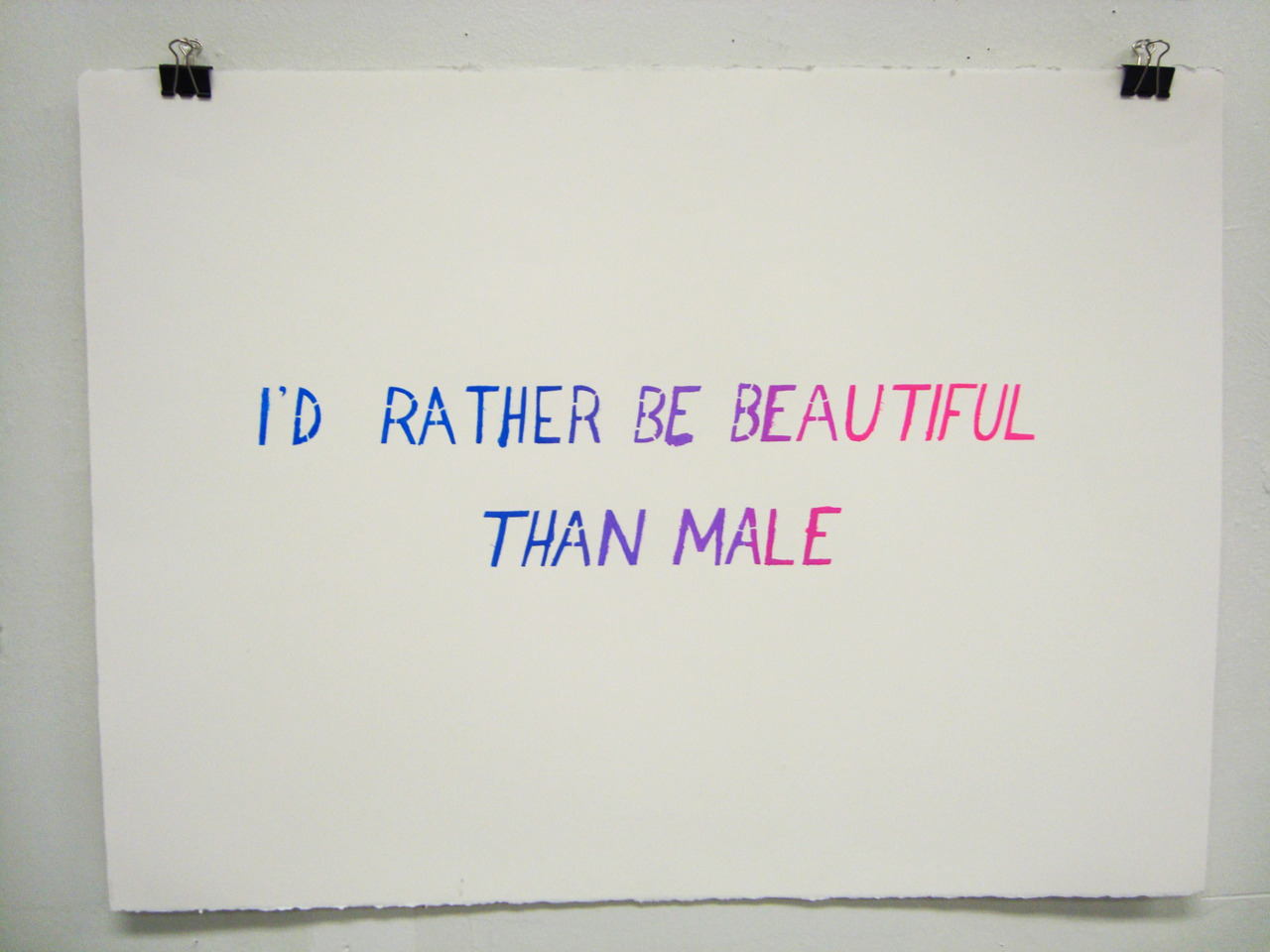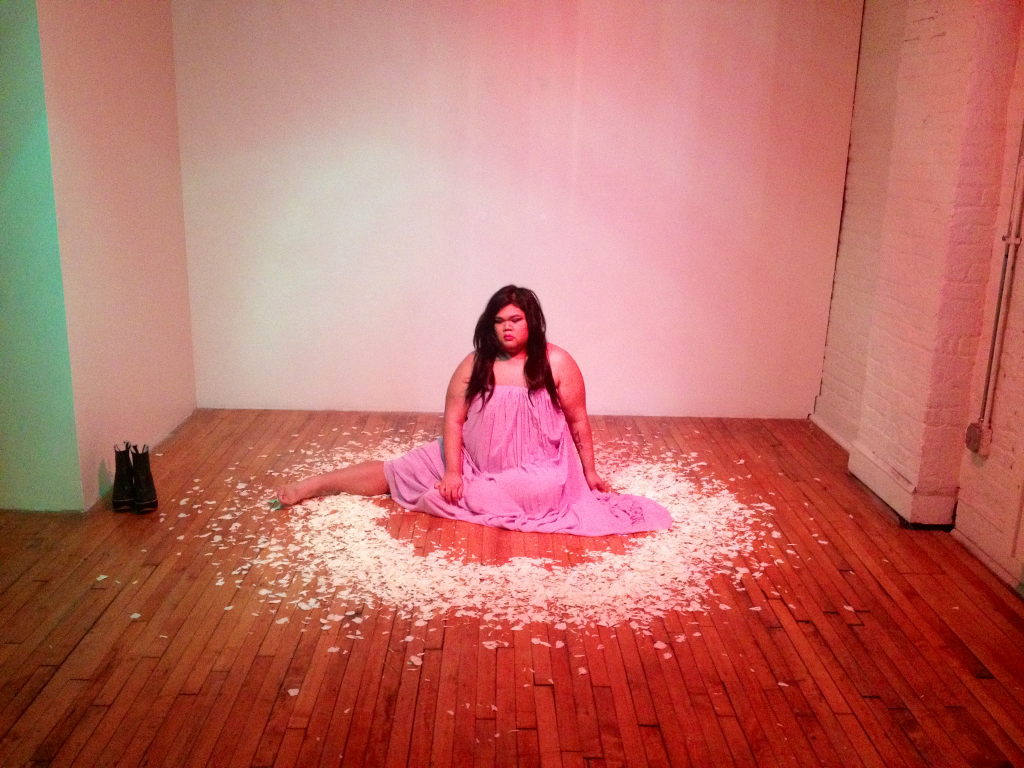“You don’t even know who I am,” the lyrics tease, “I’m the girl who parties like a man.” A dance beat comes in and the artist in the video takes out a tub of hair pomade. She playfully combs her fauxhawk from side to side while staring right at the viewer. The music continues: “why be ugly when you can be bee-youuuu-tifulll.” She takes out a small comb and smooths her hair back into a neat pompadour. She stares at the camera, her hair-do complete as the word “beautiful” repeats.
Known as the “Call Out Queen,” this YouTube video’s creator and star is Mark Aguhar, a transfeminine, Filipinx multidisciplinary artist whose work blurred the lines between high art and everyday expression. As an MFA student at the University of Illinois at Chicago, Aguhar cultivated a subversive online presence dedicated to a high-femme, queer, brown girl aesthetic. Through her visual art, videos, and Tumblr posts, Aguhar critiqued normative beauty standards, called out racism, misogyny, and fatphobia, and expanded conventional understandings of femininity. Although Aguhar died by suicide on March 12, 2012, her legacy continues to teach us about the possibilities we can find in queerness, and the power of everyday expression as a tool for survival.
Videos by VICE
Aguhar’s work reflects not only the convergence of her multiple identities—queer, trans, fat, femme, and brown—but also how these intersections can be fostered to create an everyday art practice that’s rooted in self-care. Aguhar’s 2011 video, “WHY BE UGLY WHEN U CAN BE BEAUTIFUL” demonstrates how—for someone whose everyday existence as a queer, transgender person is vulnerable to harassment and violence— the daily act of fixing one’s hair can be a form of radical resistance. In it, she flips the script on normative standards that declare fat, brown, and transfeminine bodies too “ugly” for dominant culture, insisting on their beauty.

This emphasis on art as a tool for self-preservation amidst oppression is articulated on Aguhar’s popular blog Call Out Queen, the tagline of which was “BLOGGING FOR BROWN GURLS”:
“what i was thinking today // is that art has always been a
survival tool for me // i’m USING art, i don’t think of my-
self as an artist before i think of myself as a person // and if
what i’m making isn’t art anymore // i don’t really care //
because i’m doing what i need to to survive in my own mind”
Aguhar created artwork that claims space for people who exist outside the gender binary, and insists on our right to lead fulfilling lives. In her text paintings, which are made from paper embossed with messages in glitter, such as “I’d Rather Be Beautiful Than Male,” Aguhar demonstrated the playful and colorful potentials she saw in femininity. This powerful statement not only offers up queer tenacity, but also highlights the importance of expanding the notions of femininity beyond the cisgender female experience. As mainstream feminism addresses issues like the pervasiveness of sexual violence against women in our culture, the need to include trans women and nonbinary femmes in these conversations is more urgent than ever.

According to the 2012 National Transgender Discrimination Survey, 63 percent of respondents said they had experienced serious acts of discrimination, and Asian and Pacific Islander transgender people reported a high unemployment rate at 12 percent—nearly twice the rate of the general population at the time. Aguhar alluded to the need to tackle and examine gendered and racial violence in her Tumblr post from April 19, 2011:
“BEING IN BROWN QUEER SPACE MAKES ME FEEL SIMULTANEOUS JOY AND RAGE. JOY THAT I AM IN A SPACE WHERE I DON’T HAVE TO CHOOSE WHO I AM…RAGE THAT WHEN A WHITE PERSON APPROACHES ME THEY HAVE TO PREFACE OUR CONVERSATION WITH THEIR FETISHIZATION OF ASIANS, AND WHEN I LOOK AT THEM, I JUST SEE A HUMAN BEING. RAGE THAT I CAN FEEL THE DIFFERENCE ON A DAILY BASIS BETWEEN WHERE I CAN FEEL SAFE AND WHERE I CAN FEEL AT RISK.”
– via Call Out Queen Zine
Aguhar articulated the need for feminist spaces to address how vulnerable queer and brown bodies specifically are to race and gender-based violence. Her work demanded we recognize that feminism cannot be defined by white straight cisgender experiences, and that femininity can be housed and expressed by the most beautifully subversive bodies.

Muriel Leung, a poet based in Los Angeles, explains what Aguhar’s work means to her as a queer Asian American: “For me, Mark Aguhar’s work represents a defiantly queer, trans, POC , and high femme aesthetic that insists on the visual as political, and that the breadth of such references are wide and ever-changing. I think she saw into the future of her communities in so many ways—the many modes of care and political interventions one and all can make possible. Her art means so much to me in its articulation of queer kinship, of holding multiple identities at once, and of being accountable to each other as means of cultivating better survival.”
In a Tumblr post from October 5, 2010, Aguhar’s wrote about “trying to look good while suffering.” “TAKING CONTROL OF MY PHYSICAL BODY,” she wrote, “IS THE ONLY WAY FOR ME TO EXERT AGENCY IN A WORLD DESIGNED TO DEMOLISH MY PERSONHOOD.” Aguhar’s work continues to show us how integral everyday acts of self-care are for daily survival amidst oppression, and is instructional today as it “sees into the future,” envisioning a world where the possibilities for love, pleasure, humor, kinship, and care are endless for people of all genders.
More
From VICE
-

Screenshot: Epic Games, South Park Studios -

(Photo by Mike Coppola/Getty Images) -

Fortnite Delulu -

Screenshot: Bethesda

